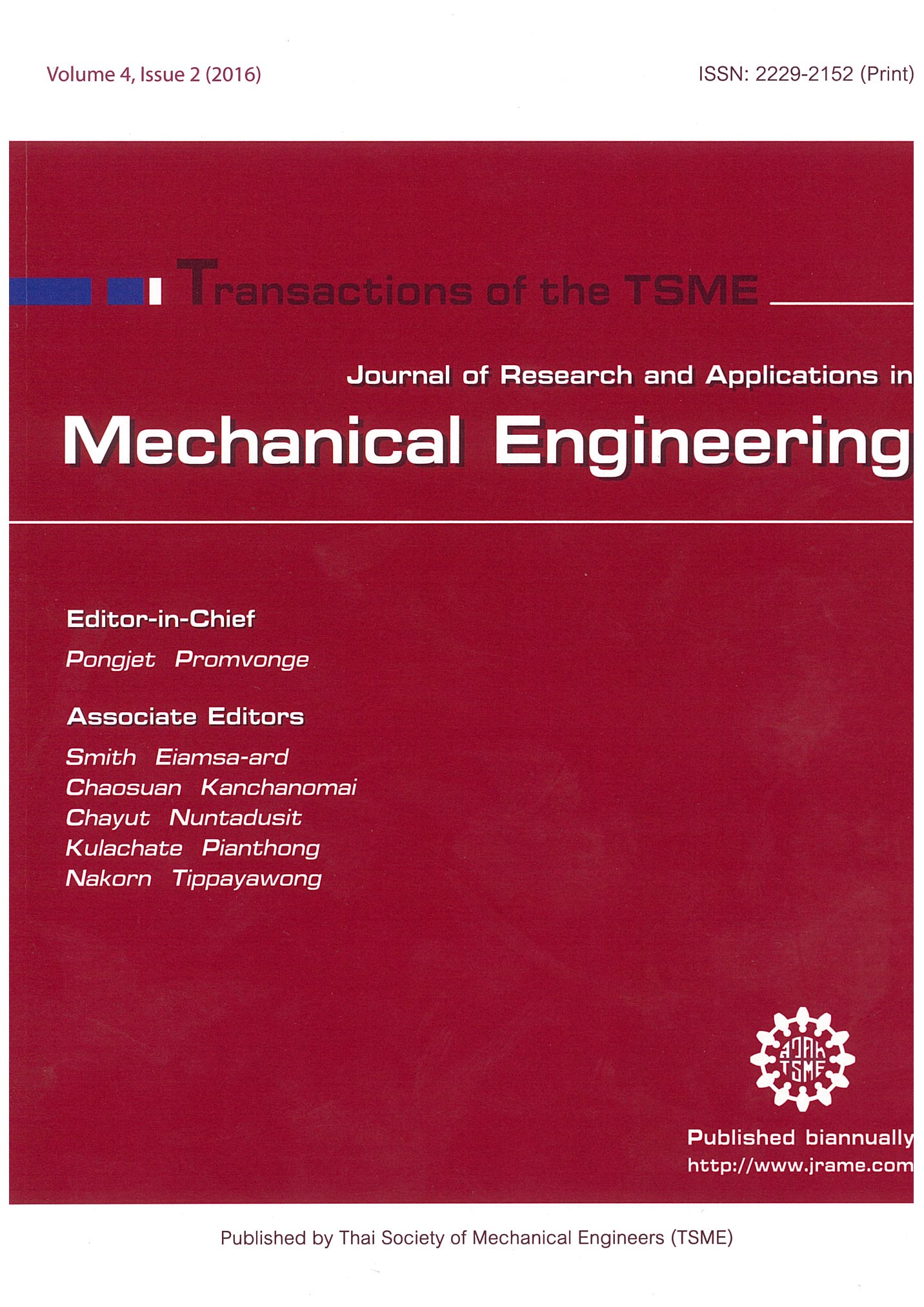Experimental study of heat transfer characteristics of stainless steel fibrous flow insulator
Main Article Content
Abstract
Flow insulation is the reduction of heat transfer of flowing fluid moving through the objects. The materials chosen for flow insulation is the porous material, which the fluid can flow through it and recover the heat from the flowing fluid leading to reduce the temperature of the fluid. The present research article aims to propose the heat transfer characteristics of the stainless steel fibrous material as the flow insulator. The stainless steel fibrous plate (porous plate) having diameter 120 mm, thickness 10, 15, 20, 25, and 30 mm, and porosities 0.9292, 0.9469, and 0.9646 were examined. In the experiment, Reynolds number 1000-2500 and the inlet air temperatures 350-550 oC were varied flowing through the porous media normally. The temperature change along the test tube, temperature drop across the porous plate, and the heat recovery efficiency were proposed. Obviously, the temperature drop across the porous plate and the thermal efficiency of the porous plate increase with the inlet gas temperature due to the effect of radiation heat transfer mode. The increasing of porosity, which decrease the heat transfer area, leads to decrease both of temperature drop and thermal efficiency. It could conclude that the fibrous porous material could be a good flow insulator at low velocity, high inlet fluid temperature and low porosity.
Article Details
This work is licensed under a Creative Commons Attribution-NonCommercial-ShareAlike 4.0 International License.
References
[2] Hanamura, K. and Echigo, R., An analysis of flame stabilization mechanism in radiation burners, Warme-und Sttoffubertragung, Vol. 26, 1991, pp. 377-383.
[3] Hanamura, K., Echigo, R. and Zhdanok, S. A., Superadiabatic combustion in a porous medium, Int. J. Heat Mass Transf., Vol. 16, 1993, pp. 3201-3209.
[4] Jugjai, S. and Chuenchit, C., A Study of energy conversion by a porous combustor-heat exchanger with cyclic flow reversal combustion, Int. Energy J., Vol. 2, No. 2, 2001, pp. 95-104.
[5] Echigo, R., and Hasegawa, S., Radiative heat transfer by flowing multiphase medium-Part I. An analysis on heat transfer of laminar flow between parallel flat plates, J. Heat Mass Transfer, Vol.15, 1972, pp.2519-2534.
[6] Echigo, R., Hasegawa, S. and Tamehio, H., Radiative heat transfer by flowing multiphase medium-Part II. An analysis on heat transfer of laminar flow in an entrance region of circular tube, J. Heat Mass Transfer, Vol.15, 1972, pp.2595-2610.
[7] Tamehiro, H., Echigo, R. and Hasegawa, S., Radiative heat transfer by flowing multiphase medium-Part II. An analysis on heat transfer of turbulent flow in a circular tube, Int. J. Heat Mass Transfer, Vol.16, 1973, pp.1199-1213.
[8] Hasegawa, S., Echigo, R., and Shimizu, A., Convective and Radiative Heat Transfer of Flowing Gaseous-solid Suspensions: in Handbook of Heat and Mass Transfer, Heat Transfer Operation, Gulf Publishing Company, Vol.1,1986, pp.523-558.
[9] Echigo, R., Effective Energy Conversion Method between Gas Enthalpy and Thermal Radiation and Application to Industrial Furnaces. Proc.7th Int. Heat Transfer Conf. Vol. 6, 1982, pp. 361-366.
[10] Viskanta, R., Overview of radiative transfer in cellular porous materials, in: Proc. ASME 2009 Heat Transfer Summer Conf., July 19-23, San Francisco, CA, 2009.
[11] Wang, K. Y. and Tien, C. L., Thermal insulation in flow system: Combined radiation and convection through a porous segment. ASME. J. Heat Transfer Vol.106, 1984, pp. 453-459.
[12] Khantikomol, P., Saito, S. and Yokomine, T., Study of Multilayer Flow Insulation utilizing Open-Cellular Porous Plates. Proc. Int. Conf. Power Engineering (ICOPE-09), Vol. 3, 2009, pp.37-42.
[13] Khantikomol, P. and Kamiuto, K., Combined Forced-Convection and Radiation Heat Transfer in an Open-Cellular Porous Plate. Proc. of Int. Conf. on Thermal and Fluids Engineering (The 7th JSME-KSME), 2008.
[14] Kamiuto, K., Study of Dul’nev’s Model for the Thermal and Radiative Properties of Open-Cellular Porous Materials. JSME Int. J., Series B Vol.40, 1977, pp. 577-582.
[15] Kamiuto, K., Combined conductive and radiative heat transfer through open-cellular porous plates. JSME Int. J., Series B Vol.43, 2000, pp. 273-278.
[16] Kamiuto, K., Modeling of elementary transport processes and composite heat transfer in open-cellular porous materials. Trends in Heat, Mass & Momentum Transfer, Vol.5, 1999, pp. 141-161.
[17] Kamiuto, K., Saito, S. and Ito, K., Numerical model for combined conductive and radiative heat transfer in annular packed beds. Numerical Heat Transfer Part A, Vol. 23, 1993, pp. 433-443.
[18] Kamiuto,K. and Yee, S. S., Heat transfer correlations for open-cellular porous materials, Int. Communi. Heat Mass Transfer, Vol.32 No.7, 2005, pp. 947-953.
[19] Khantikomol, P. and Kamiuto, K., Design considerations of porous gas enthalpy-radiation converters for exhaust-heat recovery systems. J. Thermal Science and Technology, Vol. 3 No.2, 2008, pp. 319-329.
[20] Khantikomol, P., Saito, S., Kamiuto, K. and Yokomine, T., Study on single layer flow insulation utilizing NiCr open-cellular porous plate, International Communications in Heat and Mass Transfer, Vol. 37, 2001, pp. 1015–1024.



